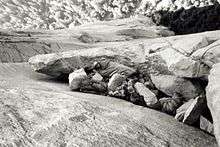Bivouac shelter


A bivouac shelter is any of a variety of improvised camp sites such as those used in scouting and mountain climbing. It may often refer to sleeping in the open with a bivouac sack, but it may also refer to a shelter constructed of natural materials like a structure of branches to form a frame, which is then covered with leaves, ferns, and similar material for waterproofing and duff (leaf litter) for insulation. It is sometimes called a bivvy for short.
The word bivouac is French and ultimately derives from an 18th-century Swiss German usage of beiwacht (bei by, wacht watch or patrol).
Construction
Single-sided designs allow easy access and allow the heat of a fire into the shelters, while full roofed designs have much better heat retention. As a general rule the roof should be at least a foot thick and opaque to bright sunlight. Artificial bivouacs can be constructed using a variety of available materials from corrugated iron sheeting or plywood, to groundsheets or purpose-made hootchies (bashas). Although these have the advantage of being speedy to erect and resource efficient they have relatively poor insulation properties.
A basha (or "hootchie") is a simple tent, made from one or two sheets of waterproof fabric and some strong cord. Generally a basha is made of reinforced nylon with eyelets and loops or tabs located along all four sides of the sheet and sometimes across the two central lines of symmetry. The basha is an extremely versatile shelter that can be erected in many different ways to suit the particular conditions of the location. (The word also sometimes refers to a special type of bivouac sack.)
There are many different ways to put up a bivouac shelter. The most common method is to use one bivouac sheet as the roof of the shelter and a second as the groundsheet. The 'roof' flysheet is suspended along in its ridge line by a cord tied between two trees which are a suitable distance apart. The four corners of the flysheet are then either pegged out or tied down to other trees. Care must be taken to leave a gap between the ground and the sheet to ensure that there is enough air flow to stop condensation.
Boofen
In the German region of Saxon Switzerland in the Elbe Sandstone Mountains climbers refer to overnighting in the open air as Boofen (pronounced "bo-fen"). The spot selected for overnight stays usually comprises an overhang in the sandstone rock or a cave, the so-called Boofe ("bo-fe"). This has often been adapted with a sleeping area and fireplace.
In the national park itself, Boofen is only permitted at designated sites and only in connection with climbing, although in this case lighting fires is absolutely forbidden.
The colloquial Saxon word boofen was derived from pofen (= sleep soundly and for a long time).
See also

.svg.png)